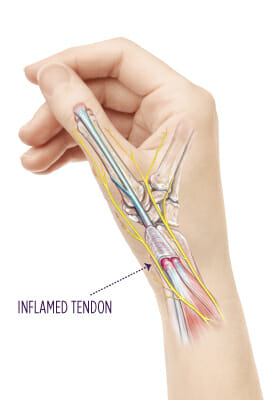

De Quervain’s Tenosynovitis
De Quervain’s tenosynovitis is a painful condition that affects the tendons on the thumb side of the wrist. It develops when the protective sheaths housing the tendons that control thumb movement become inflamed, leading to tenderness, pain and swelling. Overcoming the pain of de Quervain’s tendosynovitis can be difficult without treatment.
The condition gets its name from Fritz de Quervain, a Swiss surgeon who first described it in 1895. De Quervain’s tendosynovitis is also known as de Quervain’s tendonitis, de Quervain’s disease, de Quervain’s syndrome and de Quervain’s. About 1% of the population has the condition.
Summit Orthopedics’ hand and wrist specialists provide expert diagnosis and treatment for De Quervain’s tenosynovitis at locations throughout the Minneapolis/St. Paul area.
Symptoms of De Quervain’s Tenosynovitis
Tenosynovitis causes a range of symptoms, including:
- A swollen thumb
- Burning pain or tingling over the tendons in this area
- Pain at the base of thumb or wrist
- Painful clicking and popping
- Swelling over the irritated area of the wrist
- Weakness with certain movements
Risk Factors for De Quervain’s Tenosynovitis
Some people have a higher risk of developing the condition, including:
- New mothers and those caring for very small children, due to repetitive actions like lifting a child
- People who engage in repetitive wrist movements, like playing sports, video games or musical instruments
- Pregnant women, due to hormonal changes that cause fluid buildup in the wrists and hands
De Quervain’s Tenosynovitis Causes
Inflammation caused by overuse of the thumb can lead to de Quervain’s tendonitis and tenosynovitis. Several factors can contribute to the inflammation, including:
De Quervain’s Tenosynovitis Diagnosis
To diagnose de Quervain’s tenosynovitis, your doctor will perform a physical exam, where they examine your hand and wrist for swelling. They will also perform a Finkelstein test, during which you will bend your thumb across your palm toward your pinky and make a fist, and your doctor will bend your wrist toward your little finger. If you feel pain on your thumb side of your wrist—specifically near your thumb base—the test indicates that your thumb tendons are inflamed, and you have de Quervain’s tendosynovitis.
Treatment for De Quervain’s Tenosynovitis
According to the American Academy of Orthopaedic Surgeons, most people with de Quervain’s tenosynovitis will find that their symptoms improve with treatment. Between 50% and 80% of people will be successfully treated without surgery, and approximately 20% will experience relief with surgery.
If your doctor diagnoses you with de Quervain’s, your personalized treatment plan may include:
Splinting
A wrist splint may be recommended, depending on the severity of your condition. It wraps around the wrist to provide support and keep it from flexing and bending. If you have de Quervain’s, moving your wrist could worsen the pain and injury.
Icing the Wrist and Thumb
Ice causes the blood vessels to constrict, which slows blood flow to the inflamed tendons and reduces inflammation and pain in the wrist and thumb. You should ice your wrist and thumb for 20 minutes at a time several times a day.
Anti-inflammatory Medications
Ibuprofen and other anti-inflammatory medications are usually used to treat de Quervain’s tenosynovitis. They help reduce swelling and pain.
Injections
Cortisone injections, which are also called corticosteroid shots, are powerful medications that can reduce pain and swelling in your wrist and thumb. To treat de Quervain’s, a healthcare professional will use ultrasound guidance to inject the medication directly into the tendon sheath on your wrist that is causing your pain.
Most people who receive a cortisone injection experience significant improvement after a single shot, but others may need to have the procedure repeated.
Surgery
If other nonsurgical treatments aren’t effective, your doctor may recommend surgery. The goal of surgery is to release the pressure on the wrist tendons.
During the procedure, your surgeon will make a small incision near the base of the thumb and cut the sheath that is compressing the tendons. This allows the tendons to move more freely and reduces pain. The surgeon uses sutures to close the tendon.
Surgery for de Quervain’s tenosynovitis is a minimally invasive, outpatient procedure, meaning you can return home on the same day of the surgery.
Recovery From De Quervain’s Tenosynovitis
Once painful symptoms have subsided, your hand surgeon may recommend a strengthening exercise program for your thumb and wrist.
Your recovery time depends on your age, general health and the duration of your symptoms. With cases that have developed over time, de Quervain’s may take longer to respond since the disease is often more resistant to change.
Find your Summit Orthopedics hand and wrist expert, request an appointment online or call us at (651) 968-5201 to schedule a consultation.
